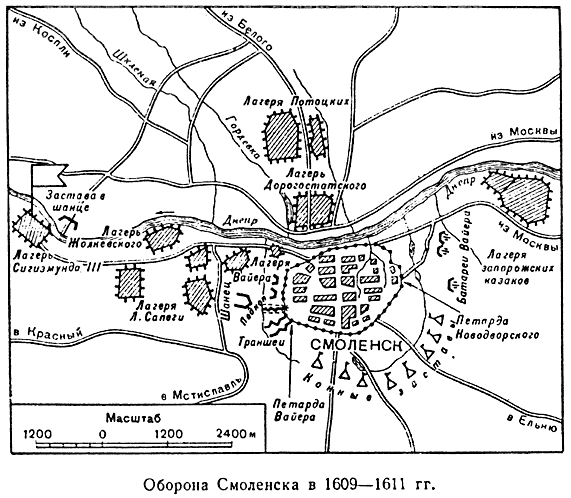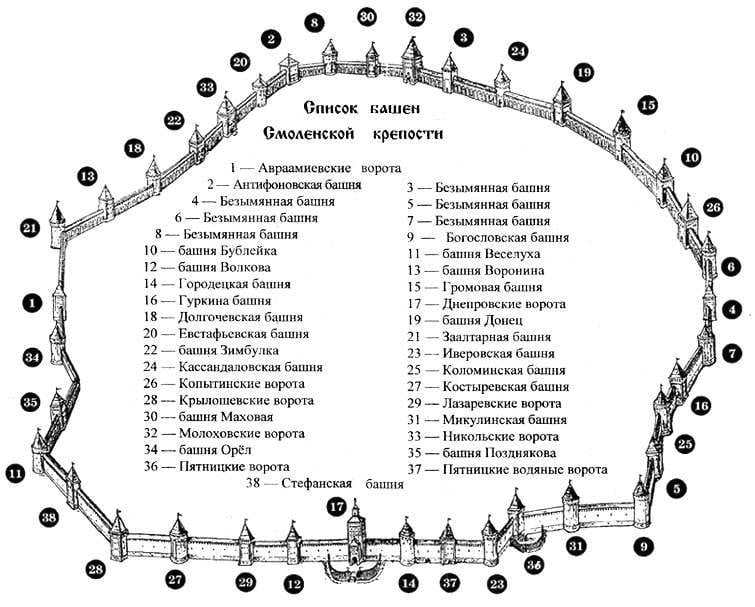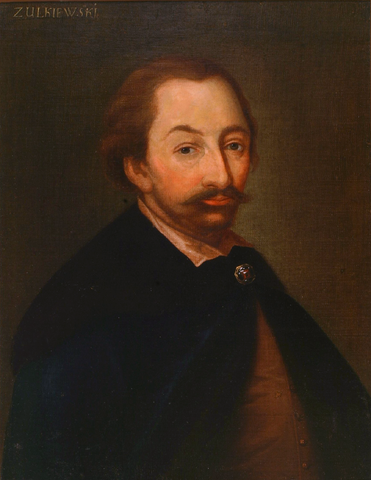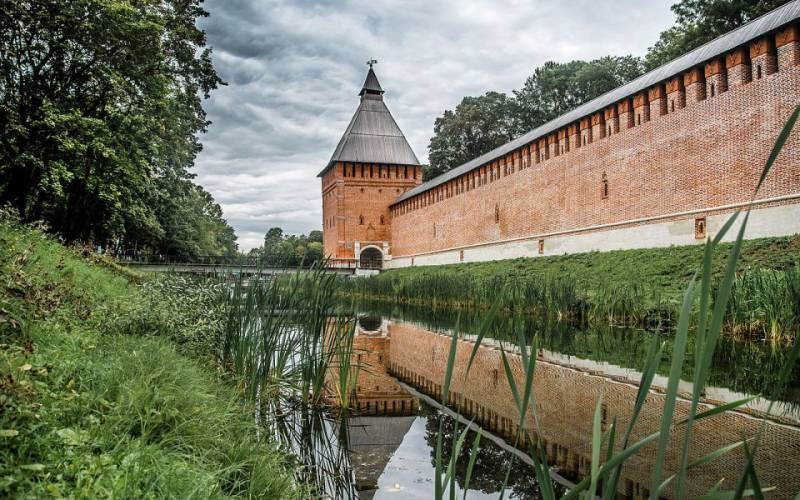How the Polish army stormed Smolensk
After exploring the fortifications of Smolensk and discussing at the military council ways of mastering the fortress, hetman Stanislav Zolkiewski was forced to report to King Sigismund III that the Polish army did not have the forces and means necessary for assault: numerous infantry, siege artillery and appropriate supplies and equipment. He proposed to the king to confine himself to the blockade of the fortress, and to go to the capital of the Russian kingdom as the main forces.
However, the king considered retreat disgrace for himself. Leaving a strong fortress in the rear seemed dangerous, and it looked like a light, seductive prey. In addition, reinforcements arrived - 10 ths. Cossacks Olevchenko. On the side of the king lay chieftain Nalyvayko. For the excesses in the Vladimir region, the False Dmitry and the Tushino boyars were angry with him, and he went to the Polish king. Numerous Cossack troops almost did not participate in the siege, but flooded with gangs the western Russian counties, blocking all roads and thus creating the outer ring of Smolensk’s environment.
As a result, the king decided to seize Smolensk by all means and rejected the proposal of Zolkiewski. Fulfilling the royal will, hetman Zolkiewski ordered the storming of the fortress to begin on the night of September 25. It was planned to destroy the Kopytitsky (western) and Avraamiyevsky (eastern) gates with subversive shells and break through them into the Smolensk fortress. For the assault, infantry companies of the German and Hungarian mercenaries were allocated, and the best mounted hundreds were prepared to break through the gates. To distract the garrison was gun-gunnery around the perimeter of the fortress. She was supposed to create the appearance of a general assault on the Russian fortress.
Mikhail Shein provided for such a scenario, and all the gates of the fortress were previously covered with log cabins filled with earth and stones. This protected them from siege artillery fire and possible explosions. For the passage, narrow gaps were left, into which one person could pass, and it was easy to defend them with small forces (they later fell asleep). As a result, Polish sappers were able to destroy only the Avraamiev gate, but Polish troops did not receive a conditional signal and were discovered. The defenders of the eastern wall lit torches, saw the enemy and covered the order of artillery prepared for the attack. Polish forces, standing in tight rows, suffered heavy losses and withdrew. Thus, the night assault was foiled.
However, the Polish command did not abandon the assault. September 25-27 were fighting hard. The Poles moved the main direction of impact on the northern and western walls. The most fierce battle unfolded along the northern walls at the Dnieper and Pyatnitsky gates, and along the western wall - at the Kopytinsky gate. The attacks of the Poles were everywhere reflected, with significant losses for them. A major role in the success of the defense was played by the reserve created in time by Shein, who was quickly transferred to the most threatened sectors. In addition, the defenders of the fortress, reflecting the attacks of the enemy, at the same time improved the system of fortifications. The gaps were immediately repaired, the gates, without which it was possible to do, were covered with earth and stones, the log houses in front of the gates were covered with a fence with a guard.
After the failure of the assault, the Polish command did not abandon plans to capture Smolensk. The Poles decided in a short time to weaken the defense of the Russian fortress with the help of engineering work and artillery fire, and then begin a second assault. However, the effectiveness of the fire turned out to be low, the Poles had little artillery, and besides, they were low-powered cannons that could not bring serious damage to the powerful walls of the fortress. The fortress artillery of the Russian garrison fired a successful response fire, inflicted great damage to the Poles, disrupted engineering training. In this situation, Sigismund was forced to abandon the re-assault of the fortress, and from October 5 1609, the Polish army moved to the siege.
Shein mobilized the entire population of the city in November “for all the torch and the sacrum and for all the townships and the streets ... for painting on the city ... with every fight, and those people would stand in full and in their place with their fight without any reservations with great care on the lookout, and there will be no death penalty on the painting on the city, and that will be executed by death. "

Source: E. A. Razin. History military art
Siege
The engineering work of the Poles was also not successful, although they were led by experienced foreign specialists. Under the foundations of the walls of the fortress were "rumors" - galleries intended for attacks outside the fortress and mine action. Voevoda Shein ordered to build additional "rumors", to strengthen intelligence on the approaches to the fortress. Russian warriors launched countermining work.
16 January 1610, the Russian miners got to the Polish undermining and destroyed the enemy who was there, and then blew up the gallery. Some military historians, for example, E. A. Razin, believe that this was the first underground battle in military history. 27 January Smolensk miners won another victory over the enemy. The Smolensk warriors installed a powerful pishchal in the gallery this time and loaded it with a core with a “stinking” composition (saltpeter, gunpowder, sulfur, vodka and other substances). The tunnel was blown up. Soon Smolensk could blow up another Polish mine, proving the futility of waging a mine war against them. Thus, the Russian warriors won the underground war of the winter of the 1609-1610 years.
At the same time, when there was an underground war, the Russian garrison made attacks, in which hundreds of warriors participated, not giving the Polish army a quiet living. Also, the attacks were made in order to get water in the Dnieper (it was not enough in the fortress, or the quality of the water was low), and in the winter for firewood. So, during one of the sorties, several Smolensk citizens moved by boat across the Dnieper, quietly made their way into the Polish camp, captured the royal banner and returned safely to the fortress. At the same time, a partisan struggle unfolded in the Smolensk region, which is not surprising, given the customs of the armies of the time - the supply at the expense of the local population (actual robbery), looting, violence against people. Partisans strongly interfered with the enemy, attacking his foragers, small units. An outstanding Russian commander Skopin-Shuisky helped in the organization of the partisan movement. He sent military specialists to Smolensk to organize sabotage war and disorganize the enemy’s rear.

Klushinskaya catastrophe and its impact on the defense of the Smolensk fortress
The siege of Smolensk shackled a large part of the Poles' army, which allowed Skopin-Shuisky to accomplish a number of victories, vast areas in the north-west of the Russian state were cleared of the enemy, and the Tushinsky camp of Lzhedmitry II was eliminated. In March, 1610 was able to free the capital from the siege. Subsequently, Skopin’s detachments smashed several Polish and Tushino detachments and freed the road to Smolensk.
Thus, you can speak at Smolensk. All conditions were created: a strong army was formed; crushed by the auxiliary forces of the enemy; Smolensk road cleared. However, Skopin died suddenly (apparently, he was poisoned). Dmitry Shuisky, a talentless one, was appointed commander-in-chief of an excellent army created and trained by Skopin. According to Polish data, under the authority of Shuisky there were 40 thousand Russian soldiers and 8 thousand mercenaries of Delagardi. According to other sources, the Russians were 20-30 thousand. Mercenaries - 7-8 thousand people.
24 June (4 July) 1610, near the village of Klushino, the troops of Shuisky were attacked by the army of Hetman S. Zolkiewski. According to various data, the Polish army numbered from 7 to 12,5 thousand people, and consisted practically of the same cavalry and had no artillery. However, the relatively small Polish army defeated the numerically superior Russian-Swedish army of Shuisky and Delagardi. One of the main reasons for the decisive defeat was the fatal mistakes of the Russian commander, who placed the infantry troops behind the regiments of the noble cavalry, but without cover by field fortifications. The unpreparedness of the Russian-Swedish army to the battle also played its role. Not all the troops managed to take part in the battle, Shuisky did not have time to pull the 18 guns he had with him to the battlefield.
Mercenaries and Russian cavalry withstood the first attacks of the winged hussars of Zolkiewski. A persistent battle lasted for several hours. However, in the end, the noble cavalry overturned by the Poles fled and overturned their infantry on the way. Most of the troops fled through the forests, Shuisky with several thousand archers and artillery confused and sat down in the camp, refusing to continue the struggle. Delagardi mercenaries (mostly French and Scots), realizing that the battle was lost, changed the Russian. They began negotiations with Zolkiewski. A part went over to the side of the Polish-Lithuanian Commonwealth, the rest were promised free passage for the promise of no longer fighting against Sigismund III in the Russian kingdom. Seeing the departure of the Swedes, the remaining Russians fled. In addition, after learning about the defeat of the main army, blocked before Tsarevo Zamische, before the battle, another part of the Russian army (detachments of F. Yeletsky and G. Valuev, about 8 thousand people) folded weapon and moved to the side of the Poles.
Thus, the Russian army ceased to exist. The Swedes after Klushinsky defeat went to the north, received reinforcements and began to seize the Novgorod land. The Polish army was significantly strengthened by the mercenaries who had transferred to the service of Sigismund, the Russian troops, who swore allegiance to Prince Vladislav. Following the defeat in Moscow, Vasiliy Shuysky was overthrown (he was tonsured as a monk) and the temporary boyar government of Semiboyarshchina was formed (“Bolar power”), which, in fear of Falsdmitry II and not being able to retain power on its own, swore to Vladislav and let in Moscow Zolkiewski army. However, Smolensk, and in the absence of hope for outside help, continued to resist until the summer of 1611.

Polish commander of the beginning of the XVII century, the great hetman and Chancellor the great crown Stanislav Zolkiewski
The fall of the Russian stronghold
The position of Smolensk was hopeless, but neither the lack of outside help, nor the siege, nor hunger and disease broke the courage of the Russian people. While the forces of the defenders dried up, and there was no help, more and more reinforcements arrived to the Polish army. In the spring of 1610, under the fortress, Polish troops arrived, who had previously served the second impostor. Significant forces came from the Commonwealth. The number of landsknechts - German mercenaries increased. In total, the army received 30 thousand reinforcements and siege artillery. Then the Polish army intensified when the Russian army was defeated at Klushin. But the garrison was not going to surrender, all the attempts of the Poles to persuade Smolyan to surrender were not successful.
In July, the Polish army resumed active engineering work on 1610, while the resulting siege artillery and walling machines began to be used simultaneously. Polish engineers laid the trenches and began to move to the tower at the Kopytitsky gate. The garrison led trenches to counteract the advancement of the enemy and the Russian warriors destroyed part of the moves of the enemy. Although the Poles did reach the tower, all attempts to break through its powerful foundation did not lead to success. By July 18, having concentrated almost all their siege artillery here, the Poles were able to make a dent. 19 July morning Polish army went on a decisive assault on the fortress, which lasted two days. Demonstrative actions were conducted on the entire front of the fortifications, and the main blow, by the forces of German mercenaries, was carried out in the area of the Kopytitsky gate (from the west). But the defenders, despite his desperate efforts of the enemy, repelled the assault. The decisive role was played by reserve units, which were brought into battle in time. 11 August defenders of the fortress repelled the third big assault. The Polish army lost up to 1 thousand people only killed.
The new Moscow government (Seven Boyarshchina) sent Shein an order to surrender the city to the Polish king. However, Shein, on his own initiative, refused to comply with this order, which was also supported by the townspeople. The angry Sigismund III gave the Smolensk three-day ultimatum on pain of death to surrender the city, but after the deadline Smolensk responded with a successful foray, undermining the battery of the Riga cannons, which they undermined. This forced the king to demand new cannons from Slutsk and provided Smolenians with another two months of respite. November 21 garrison repelled the fourth assault. The main role in repelling the enemy was again played by the reserve. The Polish army suffered significant losses and again moved to the siege, not taking active steps.
Winter 1610-1611 It was very difficult for the Russian fortress. The hunger and the epidemics that weakened people were joined by the cold; there were not enough people to go out for firewood. There was also a shortage of ammunition. As a result, by the beginning of the summer of 1611, only about 200 fighters, who were capable of holding a weapon in their hands, remained alive in the fortress garrison. This number was barely enough for perimeter surveillance. Each warrior had to watch the 20 — 30-meter section of the fortress wall. There was no more reserves. Of the residents of the city, no more than 8 thousand survived, who were on the verge of survival.
Apparently, the Poles did not know about the catastrophic position of the garrison, and the assault would have started earlier. The Polish command took the decision on the fifth assault only after one defector from the fortress, a certain Dedeshin, spoke about the plight of Smolensk. He pointed out the weakest point of defense of the fortress in the western part of the Smolensk wall. In recent days, before the decisive assault, the Polish army subjected the fortifications to powerful shelling. But its efficiency was still low, it was possible to break a small gap only in one place.
In the evening of June 2, the last assault on the city began. The Poles were able to blast down part of the wall. Through the breach, the Poles broke into the city. At the same time in another place, the German mercenaries climbed the stairs to that part of the fortress wall, which even at night there was no one to protect. A handful of Smolensk defenders headed by voivod Mikhail Shein gave the final battle to the enemy, trying to stop the enemy from breaking through. Several dozen Russian soldiers in a fierce battle with the enemy killed almost everything.
Despite the stalemate, Smolensk did not surrender, they continued to fight in the city, a fierce battle on the streets went all night. The last stronghold of defense was the Assumption Cathedral on the Cathedral Hill, in the basements of which were stored stocks of gunpowder. About 3 thousands of people, mostly old men, women and children, sheltered there. When the last defenders of the Cathedral Hill fell in battle with the enemy, the Smolensk citizens set fire to the powder cellar and blew themselves up together with the enemies so as not to be captured by the cruel enemy. Unknown Russian patriots preferred death to captivity ...
Wounded Shein, entrenched with a handful of warriors in one of the fortress towers, the Poles captured and subjected to brutal torture. During the interrogation, the courageous commander was asked who advised him and helped him stay in Smolensk for so long? To which he replied: "No one in particular, because no one wanted to give up." Shein was sent to Lithuania. There he was held in chains for nine years.
Kopyten tower
Results
20-month unprecedented defense of Smolensk ended on a high note. The Russian garrison fought to the end, having exhausted all defensive capabilities. What the enemy could not do, made hunger, cold, and disease. The Russian garrison fell in battle entirely, out of tens of thousands of city dwellers, several thousand people survived, sick and completely exhausted. Smolensk was an example of all of Russia, how to fight the enemy - to the last, even without hope of success.
The defense of Smolensk once again showed the heroism and self-sacrifice that the Russian people, who had risen to fight with the enemies, are capable of. The heroes of Smolensk became an example for the whole Russian kingdom, including the warriors of the First and Second militias. In all corners of the Russian land, anxiety and pain followed the course of the struggle for the Smolensk fortress. So, the heroic defense of Smolensk set as an example to his warriors voivod Dmitry Pozharsky.
Unfortunately, in modern Russia, the image of the heroic Smolensk, its governor, defenders and residents is almost unknown. Although the heroic defense of Smolensk is worthy of big historical films, serials. And the images that Smolensk gave us can help in the patriotic education of the younger generations. But, the current leaders of the "culture" prefer to shoot pro-American "pop", aimed at fooling, westernizing and decomposing young people.
In the military-strategic sense, the long defense of Smolensk played a big role in the future fate of Russia. The Smolensk garrison, residents of the city for almost two years bound the main forces of the enemy's army, thwarted the plans of the Polish leadership for the lightning campaign and the occupation of the vital centers of Russia. And this created the conditions for a successful national liberation struggle of the Russian people against the interventionists. They fought and died for good reason. Sigismund used all available financial and material resources to form a large siege army. The Polish army was drained of blood (having lost up to 30 thousand people) and was not able to throw at Moscow. Sigismund III did not dare to immediately go to the Russian capital in order to strengthen the local Polish garrison and led the troops to Poland, where they were disbanded. To march on Moscow in 1612, he was forced to use the Lithuanian troops of Hetman Hodkiewicz, himself speaking only in the fall of 1612, could not take Volokolamsk and was forced to turn back. Smolensk itself again became part of the Commonwealth and was returned to Russia in 1654 year.
From the point of view of military art, the defense of the Smolensk fortress is a classic example of the defense of a fortified position. It should be noted that Smolensk’s good preparation for defense helped its relatively small garrison without any outside help, relying only on its own strength and resources to successfully withstand the 4 assault, a significant number of small attacks, siege numerically, professionally and technically superior army of the enemy. The garrison not only beat off assaults, but also actively counterattacked, was able to deplete the forces of the Polish army so much that even after the capture of Smolensk, the Polish army lost its offensive power.
Russian warriors showed a high level of military art. This was manifested in the high activity of the garrison, the stability of the defense, the skillful use of artillery, the victory in the underground war against Western military specialists. The command of the fortress skillfully used the reserve maneuver, continuously improving the defense of Smolensk during the conduct of hostilities. The garrison showed high morale, courage and ingenuity until the very last moments of defense. As a result, the fall of the fortress was caused not by the mistakes of the garrison, but by the complete exhaustion of its forces (there was simply no one to fight) and the weakness of the government of Vasily Shuisky, the lack of talent of a number of royal military leaders who could not unblock the besieged fortress.
- Alexander Samsonov
- Troubles
Folk hero Kuzma Minin and Smoot
How the False Dmitry I was killed
How suppressed the uprising Bolotnikov
How the False Dmitry II tried to take Moscow
The ruin of the Russian land. Heroic defense of the Trinity Monastery of St. Sergius
Skopin-Shuisky's hike: the battles of Torzkom, Tver and Kalyazino
How did the Polish invasion begin? Completion of the liberation of Moscow by the army of Skopin-Shuisky: the battle on the Karinsky field and near Dmitrov
The heroic defense of Smolensk

Information